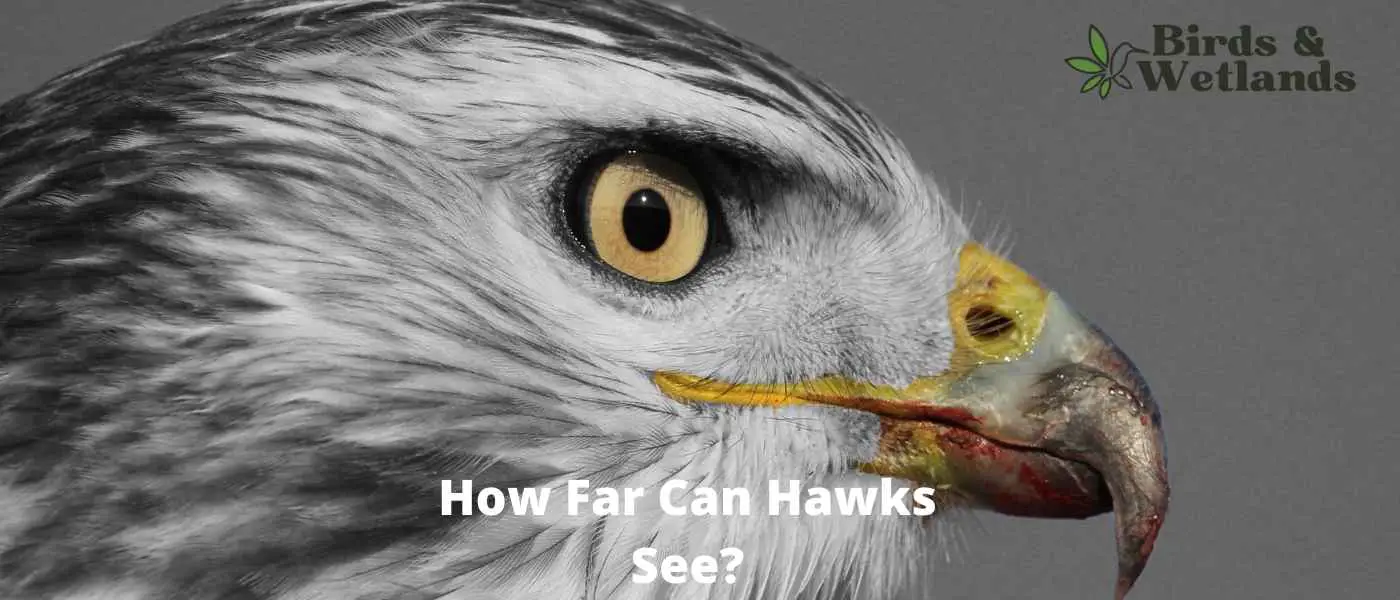Hawks are known for their good eyesight and excellent depth perception that allows them to can spot movement from far away.
Red-tailed hawks, in particular, have binocular vision, meaning they can see ground squirrels and other small mammals from 100 feet up in the air with both eyes. They can dive at up to 120 mph to catch their prey.
Does the Red-Tailed Hawk Have a Binocular Vision to Spot Prey Animals?
Hawks have excellent eyesight, which allows them to spot potential prey from great distances. By having two eyes that work together, hawks have what is known as binocular vision.
This type of vision gives red-tailed hawks the ability to perceive depth and judge distance, both of which are essential for hunting. And red-tails are among the largest hawks in the wild.
When a red-tail hawk is flying high above the ground, it can use its binocular vision to scan the area for movement. Once a potential target is spotted, the red-tailed hawk will then begin its dive.
During this rapid descent, the eyes of red-tails work together to keep the target in sharp focus. This allows the hawk to accurately judge its distance from the prey and strike with precision.
A third eyelid called a nictitating membrane, which semi-transparent lid that moves from side to side, gives red-tailed hawks superior vision.
Interestingly, a Cooper’s Hawk can see objects held in their beaks through the movement of their eyes.
Does a Hawk Have Better Vision Than a Bald Eagle?
Hawks, all eagles, and Old World vultures are all members of the order Accipitriformes. When it comes to vision, both hawks and bald eagles have good eyesight like most birds of prey such as Peregrine falcon, American kestrel, and Great-horned Owls.
However, each species excels in different areas. For instance, bald eagles have better distance vision than hawks. This gives them an advantage when hunting for a prey animal from the air.
Hawks, on the other hand, can see colors more vividly than bald eagles. This is likely due to the fact that a hawk such as the rough-legged hawk, red-shouldered hawk (reddish-brown), and sharp-shinned hawk hunt more often during the day.
As a result, their eyes have evolved to be more sensitive to light. So, while both red-tailed hawk and bald eagle have excellent vision, each species has a different set of strengths when it comes to this sense.
One point that is noteworthy is that these raptors will not even notice small animals such as a rabbit sitting still in a field because they are only hunting other animals.
What Colors Can Hawks See?
Hawks are known for their keen eyesight, and they are able to see a wide range of colors thanks to their highly-developed cone cells.
Like other raptors, red-tailed hawks have excellent eyesight. These large species of raptors can see colors that are similar to what humans can see, as well as ultraviolet light. This means that the rough-legged hawks can see colors that humans cannot.
Ultraviolet light is invisible to human eyes but visible to many animals, including birds. This allows hawks to see things that we cannot, such as the UV markings on some prey animals.
In addition to seeing ultraviolet light, hawks also have a higher degree of color vision than humans. This allows them to distinguish between different shades of color, which can be helpful when hunting or simply navigating their surroundings.
It is not surprising that birds active in the daytime have a color vision, as compared to nocturnal birds, which are color blind. This difference in color perception is often obvious in bird behavior.
How Wide Is a Hawk’s Field of View?
Hawks are one of the most skilled hunters in the avian world, and their impressive hunting abilities can be attributed in part to their eyesight.
Hawks have a total field of view of about 280 degrees, with around 40 degrees of binocular overlap. This gives them a wide range of vision that allows them to spot prey from great distances away.
Hawks have good depth perception, which helps them to gauge the distance to their target and make precise strikes.
Combined with their sharp claws and sharp beak, the exceptional eyesight of these birds of prey makes them efficient and deadly predators.
Conclusion on How Good Is a Hawk’s Eyesight
Hawks are pretty awesome raptors. Some of them remain and share a nest site with their mate all year round, others separate after the mating season or breeding season.
Hawks have some of the best vision in the entire animal world. Most hawks can see up to 100 feet away, making them some of the best hunters in the world.
They are capable of seeing from greater distances than human eyesight, and their visual acuity is eight times better than the human eye too even though our eyes are slightly larger than theirs.
But that comes at the expense of night vision. Regardless, their eyesight is so good that they can spot medium-sized prey from high in the sky and swoop down to catch it, and yes they will swoop down and attack small dogs and hawks will carry off chickens.
While you may not be able to see as far as a hawk, understanding how their eyes work can help you improve your own vision for success.
As we learn more about animal behavior and adaptations, we will come to understand that animals do not behave strangely or act silly, but rather they behave in ways that are perfectly suited to their survival.
FAQs on Hawk’s Vision
Do Hawks Have a Good Memory?
Hawks are intelligent predators with sharp eyesight and an excellent memory. If you have bird feeders in your yard, other birds that frequent them may quickly become hawk’s prey. Once a hawk discovers an easy food source in your yard, it will most likely return.
Hawks have a variety of methods for finding prey. They watch from a vantage point or soar high in the sky, looking for movement below. Once they spot potential prey, they dive at high speeds, using their sharp talons to capture their victim.
Thanks to their good eyesight, broad wings, and powerful memory, hawks are successful hunters that play an important role in the ecosystem, however, interestingly hawks cannot swim.
Are Hawks Smart?
Hawks are among the most intelligent birds, exhibiting a high level of cognitive ability. They are often quite intelligent in their interactions with humans and other hawks.
This intelligence is likely due to the fact that even young hawks have excellent eyesight and are able to remember past experiences in order to make better decisions in the future.
Hawks have a keen sense of hearing, which allows them to hone in on their prey. This combination of keen senses and cognitive ability makes hawks highly efficient predators. They are often considered to be one of the smartest birds in the animal kingdom.
Do Hawks Have Good Hearing?
Hawks are known for their keen eyesight, but they also have very good hearing. This is especially useful for hunting, as it allows them to locate prey from a distance. Hawks can hear frequencies that are well beyond the range of human hearing, and they are able to use this to their advantage.
For example, they can often hear the sounds of animals such as young birds perched on trees or small rodents moving through grass or leaves long before we would be able to detect anything.
Hawks are able to use their hearing to locate prey that is hidden from view. This makes them very successful hunters, and it is one of the many reasons that they are such successful birds of prey.
Are Hawks Better Hunters Than Golden Eagles?
When it comes to hunting, both red-tailed hawks and golden eagles are skilled predatory birds. Eagles are larger birds, and they have much more powerful talons than hawks do. This gives them an advantage when it comes to taking down large prey.
Hawks, on the other hand, are smaller and more agile than eagles. This allows them to maneuver more quickly and chase down smaller prey. Hawks have very sharp eyesight, which helps them to spot potential prey from a distance.
While hawk and golden eagle are excellent hunters, each has its own strengths and weaknesses. Ultimately, it is up to the individual bird to make the most of its abilities.
Do Hawks Build Nests?
Yes, hawks build nests made of branches and twigs.

Jim Addison is an avid bird watcher and has been obsessed with the activity since he was a young boy.
He has traveled all over North America in search of new and interesting species to observe, and his detailed knowledge of the subject makes him a sought-after expert on the topic.


